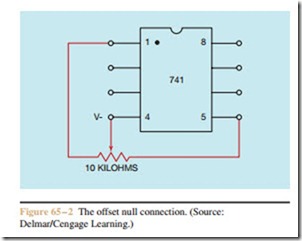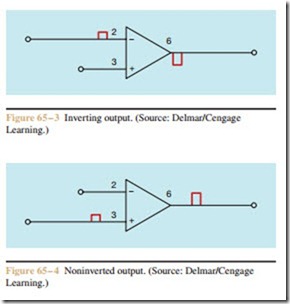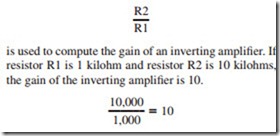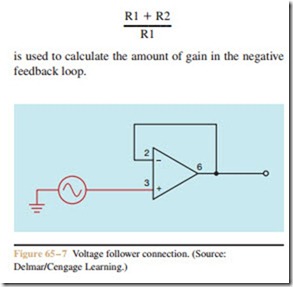The Operational Amplifier
OBJECTIVES
After studying this chapter, the student will be able to:
Discuss the operation of the operational amplifier (op amp). List the major types of connections for operational amplifiers. Connect a level detector circuit using an op amp.
Connect an oscillator using an op amp.
The operational amplifier, like the 555 timer, has become a very common component in industrial electronic circuits. The operational amplifier, or op amp, is used in hundreds of applications. Different types of op amps are available for different types of circuits. Some op amps use bipolar transistors for input while others use field effect transistors. The advantage of field effect transistors is that they have an extremely high input impedance that can be several thousand megohms. As a result of this high input impedance, the amount of cur- rent needed to operate the amplifier is small. In fact, op amps that use field effect transistors for the inputs are generally considered to require no input current.
The ideal amplifier would have an input impedance of infinity. With an input impedance of infinity, the amplifier would not drain power from the signal source; therefore, the strength of the signal source would not be affected by the amplifier. The ideal amplifier would also have zero output impedance. With zero output impedance, the amplifier could be connected to any load resistance without causing a voltage drop inside the amplifier. If it had no internal voltage drop, the amplifier would utilize 100% of its gain. Finally, the ideal amplifier would have unlimited gain. This would enable it to amplify any input signal as much as desired.
Although the ideal amplifier does not exist, the op amp is close. In this chapter, the operation of an old op amp, the 741, is described as typical of all operational amplifiers. Other op amps may have different charac- teristics of input and output impedance, but the basic theory of operation is the same for all of them.
The 741 op amp uses bipolar transistors for the in- puts. The input impedance is about 2 megohms, the output impedance is about 75 ohms, and the open loop, or maximum gain, is about 200,000. The 741 is im- practical for use with such a high gain, so negative feedback (discussed later) is used to reduce the gain. For example, assume that the amplifier has an output voltage of 15 volts. If the input signal voltage is greater than 1/200,000 of the output voltage, or 75 microvolts,
the amplifier will be driven into saturation, at which point it will not operate.
The 741 operational amplifier is usually housed in an eight-pin, in-line, integrated circuit package (Figure 65– 1). The op amp has two inputs, the inverting input and the noninverting input. These inputs are connected to a differential amplifier that amplifies the difference between the two voltages. If both of these inputs are connected to the same voltage, say by grounding both inputs, the output should be 0 volts. In actual practice, however, unbalanced conditions within the op amp may cause a voltage to be produced at the output. Since the op amp has a very high gain, a slight imbalance of a few microvolts at the input can produce several millivolts at the output. To counteract any imbalance, pins #1 and #5 are connected to the offset null, which is used to produce 0 volts at the output. These pins are adjusted after the 741 is connected in a working circuit. To make the adjustments, a 10 kilohm potentiometer is connected across pins #1 and #5, and the wiper is connected to the negative voltage (Figure 65– 2).
Pin #2 is the inverting input. When a signal voltage is applied to this input, the output is inverted. For example, if a positive AC voltage is applied to the inverting input, the output will be a negative voltage (Figure 65–3).
Pin #3 is the noninverting input. When a signal voltage is applied to the noninverting input, the output voltage is the same polarity. For example, if a positive AC voltage is applied to the noninverting input, the output voltage will be positive also (Figure 65– 4).
Operational amplifiers are usually connected to above and below ground power supplies. Although there are some circuit connections that do not require an above and below ground power supply, these are the exception instead of the rule. Pins #4 and #7 are the volt- age input pins. Pin #4 is connected to the negative, or below ground, voltage and pin #7 is connected to the positive, or above ground, voltage.
The 741 operates on voltages that range from about 4 volts to 16 volts. Generally, the operating voltage for the 741 is 12 to 15 volts plus and minus. The 741 has a maximum power output rating of about 500 milliwatts.
Pin #6 is the output and pin #8 is not connected. As stated previously, the open loop gain of the 741 operational amplifier is about 200,000. Since this amount of gain is not practical for most applications, something must be done to reduce the gain to a reason- able level. One of the great advantages of the op amp is the ease with which the gain can be controlled (Figure 65– 5). The amount of gain is controlled by a negative feedback loop. This is accomplished by feeding a portion of the output voltage back to the inverting input. Since the output voltage is always opposite in polarity to the inverting input voltage, the amount of output voltage fed back to the input tends to reduce the input voltage. Negative feedback affects the operation of the amplifier in two ways: it reduces the gain, and it makes the amplifier more stable.
The gain of the amplifier is controlled by the ratio of resistor R2 to resistor R1. If a noninverting amplifier is used, the formula
is used to calculate the gain. If resistor R1 is 1 kilohm and resistor R2 is 10 kilohms, the gain of the amplifier is 11.
If the op amp is connected as an inverting amplifier, the input signal will be out of phase with the feedback voltage of the output. This will cause a reduction in the input voltage applied to the amplifier and in the gain. The formula
As a general rule, the 741 operational amplifier is not operated above a gain of about 100 because it tends to become unstable at high gains. If more gain is de- sired, it is obtained by using more than one amplifier (Figure 65– 6). The output of one amplifier is fed into the input of another amplifier.
Another general rule for operating the 741 op amp is that the total feedback resistance (R1 + R2) is kept at more than 1,000 ohms and less than 100,000 ohms. These rules apply to the 741 operational amplifier but may not apply to other operational amplifiers.
Basic Circuits
Op amps are generally used in three basic circuits that are used to build other circuits. One of these basic circuits is the voltage follower. In this circuit, the output of the op amp is connected directly back to the inverting input (Figure 65– 7). Since there is a direct
connection between the output of the amplifier and the inverting input, the gain of this circuit is 1. For ex- ample, if a signal voltage of 0.5 volts is connected to the noninverting input, the output voltage will be 0.5 volts also. You may wonder why anyone would want an amplifier that doesn’t amplify. Actually, this circuit does amplify something. It amplifies the input imped- ance by the amount of the open loop gain. If the 741 has an open loop gain of 200,000 and an input impedance of 2 megohms, this circuit will give the amplifier an in- put impedance of 200 k X 2 meg, or 400,000 megohms. This circuit connection is generally used for impedance matching purposes.
The second basic circuit is the noninverting amplifier (Figure 65– 8). In this circuit, the output voltage has the same polarity as the input voltage. If the input voltage is positive, the output voltage will be positive also. The formula
The third basic circuit is the inverting amplifier (Figure 65– 9). In this circuit, the output voltage is opposite in polarity to the input voltage. If the input signal is positive, the output voltage will be negative at the same instant in time. The formula is used to calculate the amount of gain in this circuit.






